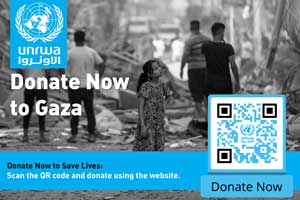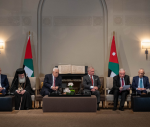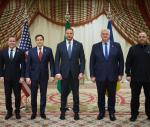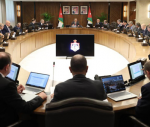You are here
Arab scenarios for confronting Palestinian displacement
Feb 08,2025 - Last updated at Feb 08,2025
Fears have recently escalated over attempts to forcibly displace Palestinians from Gaza and the West Bank, in light of the ongoing Israeli aggression targeting infrastructure and residential areas, raising doubts about the existence of a deliberate plan to empty the Palestinian territories of their inhabitants. These policies coincide with diplomatic pressures and military movements aimed at imposing a new reality on the ground, threatening to repeat the scenarios of forced displacement that the Palestinians suffered in the 1948 Nakba and the 1967 Setback.
In this context, Arab countries, led by Jordan and Egypt, find themselves facing increasing challenges that require decisive strategies to confront this threat, as three main scenarios emerge to confront displacement, each with conditions and opportunities for realisation that differ according to regional and international variables and the extent of Arab consensus.
The first scenario is a comprehensive diplomatic and strategic confrontation, whereby the Arab countries, led by Jordan and Egypt, rely on a firm diplomatic escalation in international forums, by activating the role of the Arab League and the Organisation of Islamic Cooperation, and communicating with the major powers and the United Nations to pressure to stop any attempts to forcibly displace Palestinians.
Legal tools are also being resorted to by filing lawsuits before the International Court of Justice and the International Criminal Court to hold Israel accountable, while using economic and political pressure on the countries that support it, by reviewing economic agreements and security cooperation, and imposing sanctions on companies involved in supporting the occupation’s policies.
To achieve this scenario, there must be a strong Arab and Islamic consensus, with international support based on UN resolutions that prohibit forced displacement, in addition to unifying the Palestinian position to prevent the occupation from exploiting internal divisions. Although the chances of achieving this scenario are medium to high in light of the support of some international powers for the principle of non-displacement, the obstacles lie in Western pressure on Arab countries, and political divisions that may hinder the adoption of a unified position.
The second scenario is a deterrent military and security move, whereby Arab countries, especially Egypt and Jordan, resort to taking strict military and security measures to prevent any attempts at forced displacement into their territories, by strengthening military deployment on the borders, deploying advanced surveillance systems and intensifying security patrols to prevent any illegal breaches. Buffer security zones are also being established to prevent the forced flow of refugees, with strict restrictions imposed on any uncoordinated crossings.
Coordination is taking place with the international community to send a clear message that any Israeli attempt to impose displacement will be met with diplomatic and military escalation, which may include suspending security cooperation and reviewing bilateral agreements, and even taking more severe steps, such as resorting to regional alliances to deter any Israeli escalation that threatens the stability of the region.
For this scenario to be realized, there must be a strong political decision in Egypt and Jordan to refuse to receive any waves of displacement, while strengthening military and security support on the borders, and ensuring agreement with regional and international powers to prevent Israel from exploiting the humanitarian emergency to impose a fait accompli. Although this scenario has a high chance of being partially realized, especially since Jordan and Egypt have the ability to protect their borders, the challenges lie in the international pressures that may be exerted on them under the pretext of "humanitarian necessity" to receive Palestinian refugees.
The third scenario depends on forming a regional resistance alliance and embracing the Palestinian resistance, as Arab countries, led by Jordan and Egypt, move towards forming a regional alliance to confront attempts at forced displacement, by providing intensive political support for the Palestinian cause in international forums, and enhancing the military and security capabilities of the Palestinians to confront the occupation on the ground. This alliance includes providing logistical assistance, training Palestinian security forces, and supporting development projects that enhance the steadfastness of the Palestinians in their lands.
Coordination is also taking place with influential regional countries, such as Turkey and Iran, to increase pressure on Israel and prevent the imposition of a new demographic reality. In addition, soft power is being activated through the media and popular diplomacy to mobilize Arab and international public opinion against displacement policies, and to emphasize that the Palestinians remaining in their lands is a red line that cannot be violated.
The realization of this scenario requires rebuilding regional alliances that prioritize Palestine, providing military and logistical support to the resistance inside Gaza and the West Bank, and cooperating with other regional powers to increase pressure on Israel. However, the chances of this scenario being realized remain moderate, due to the political complexities and intertwined relations between Arab countries and the West. However, the success of the Palestinian resistance in imposing the deterrence equation may enhance its effectiveness, especially if accompanied by strong official and popular Arab support.
These three scenarios represent options available to Arab countries to confront forced displacement, and each has different conditions and opportunities for realisation.
In light of the current political reality, the first scenario, which relies on diplomatic and strategic confrontation, may be the most likely, but it requires strong support to be effective. In contrast, the military and security scenario remain an available option, but it is fraught with legal and humanitarian challenges, while the third scenario depends on the extent of the Arab countries’ ability to overcome their differences and support the Palestinian resistance in more daring and influential ways. Ultimately, the success of any of these scenarios depends on the ability of Arab countries to adopt a unified position and employ all available tools of power to reject Palestinian displacement and prevent a new catastrophe.
Hasan Dajah is professor of strategic studies at Al-Hussein Bin Talal University














Add new comment